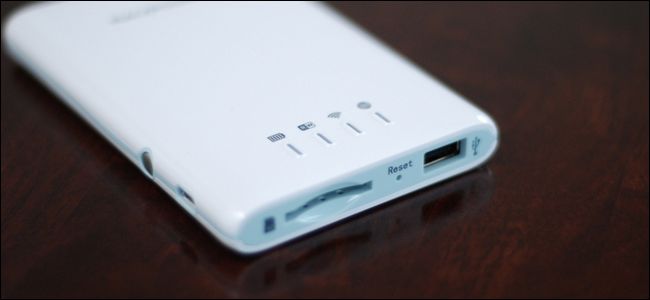
The FileHub is a little digital Swiss Army knife of useful tools; you can recharge your devices, link them together via mobile hotspot, stream files to them, and in turn back files up from your devices to the FileHub. Read on as we put it through the paces and see if a device smaller than a deck of cards can really shine in all those categories.
FileHub是瑞士数字小刀实用工具。 您可以为设备充电,通过移动热点将它们链接在一起,将文件流传输到它们,然后将文件从设备备份回FileHub。 仔细阅读我们逐步介绍的内容,看看是否能在所有这些类别中真正做到比一副纸牌更小的设备发光。
什么是RavPower 5合1 FileHub? (What Is The RavPower 5-in-1 FileHub?)
The RavPower 5-in-1 FileHub is a combination device, similar in many ways to the previously reviewed TripMate. Like the TripmMate, it’s part battery pack, part Wi-Fi hotspot, and can server as a hub for sharing and streaming files. Unlike the TripMate it does not have an Ethernet jack so it can’t function as a hardline router (to convert, say, a hotel data jack into a Wi-Fi router for your hotel room) but it does have a built-in SD card reader (a feature sorely missing from the TripMate).
RavPower 5合1 FileHub是一种组合设备,在许多方面都与以前查看过的TripMate相似。 与TripmMate一样,它是电池组,Wi-Fi热点的一部分,并且可以用作共享和流式传输文件的集线器。 与TripMate不同,它没有以太网插Kong,因此不能用作硬线路由器(例如将酒店数据插Kong转换为酒店房间的Wi-Fi路由器),但它确实具有内置SD读卡器(TripMate非常缺少的一项功能)。
Also, like the TripMate, it includes a battery that both powers the device itself and recharges other devices; the FileHub sports a 3000 mAh battery more than capable of running the devices for hours (or recharging your devices on the go).
同样,与TripMate一样,它包含一个电池,既可以为设备本身供电,也可以为其他设备充电。 FileHub拥有3000 mAh的电池电量,足以使设备运行数小时(或在旅途中为设备充电)。
如何使用? (How Do I Use It?)
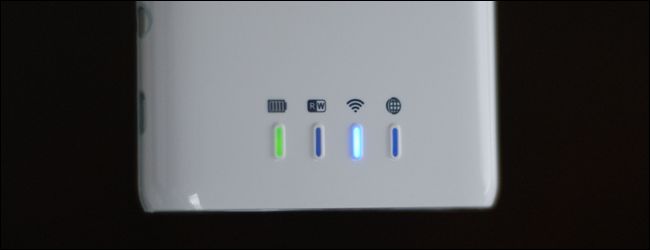
The most basic function of the FileHub is the battery backup function. To use it, you simply plug in the USB charging cable of your device into the USB port located on the edge of the device next to the SD card slot. There isn’t even a button to press, the FileHub will just start charging any device attached to it that has a partially or fully depleted battery.
FileHub的最基本功能是备用电池功能。 要使用它,只需将设备的USB充电电缆插入SD插槽旁边设备边缘的USB端口。 甚至没有按钮可以按下,FileHub会开始为连接到其中的部分电池或电池完全耗尽的任何设备充电。
The advanced functions of the device are only accessible via Wi-Fi enabled devices such as Android phones, iPads, laptops, etc. When you are ready to use the device as a Wi-Fi hotspot, transfer files to an SD card, or stream files from that SD card, you’ll need to tap the small button located on the left hand side of the device just above the micro USB charging port.
该设备的高级功能只能通过启用了Wi-Fi的设备(例如Android手机,iPad,笔记本电脑等)访问。当您准备将该设备用作Wi-Fi热点时,请将文件传输到SD卡或流式传输文件中的文件,您需要点击设备左侧微型USB充电端口上方的小按钮。
When you press that button the device will light up, as seen in the image above, with the battery light on (indicating the device is active) and the Wi-Fi light blue (indicating the Wi-Fi antenna is on).
如上图所示,当您按下该按钮时,设备将亮起,其中电池指示灯亮起(表明设备处于活动状态),而Wi-Fi指示灯亮起蓝色(表明Wi-Fi天线处于打开状态)。
In our review of the TripMate, we showed you how to setup the device from a Windows computer and how to connect to it from a Windows computer. We’re going to mix things up in this review (as the process is nearly identical) and show you how to setup the Filehub and access the files all with an Android phone.
在对TripMate的回顾中,我们向您展示了如何从Windows计算机设置设备以及如何从Windows计算机连接到设备。 在本次审查中,我们将把所有事情混在一起(因为过程几乎相同),并向您展示如何设置Filehub并使用Android手机访问所有文件。
Once the blue indicator light is on and solid, grab a Wi-Fi enabled device and look for a Wi-Fi access point with the name FileHub-XXXX wherein the XXXX is a distinguishing identifier assigned to your FileHub unit.
一旦蓝色指示灯一直亮起并稳定,请抓住具有Wi-Fi功能的设备,然后寻找名称为FileHub-XXXX的Wi-Fi接入点,其中XXXX是分配给您的FileHub单元的区别标识符。

Log into the access point; the default password is “11111111” (that’s eight one’s). After logging into the access point open up a web browser on your device and navigate to 10.10.10.254 to access the device’s administration panel. The login is “admin” with no password.
登录到接入点; 默认密码为“ 11111111”(八个)。 登录到接入点后,打开设备上的Web浏览器,然后导航至10.10.10.254以访问设备的管理面板。 登录名是“ admin”,没有密码。
Upon first administrative login you’ll be prompted with a configuration wizard which will walk you through setting up the device. The first step is focused on linking the device to an existing Wi-Fi network so that devices attached to the FileHub have Internet access; if you don’t have an available Wi-Fi network or don’t wish to link the FileHub to the network, you can skip this step.
首次进行管理员登录后,系统会提示您一个配置向导,该向导将引导您完成设备的设置。 第一步着重于将设备链接到现有的Wi-Fi网络,以便连接到FileHub的设备可以访问Internet。 如果您没有可用的Wi-Fi网络或不想将FileHub链接到网络,则可以跳过此步骤。
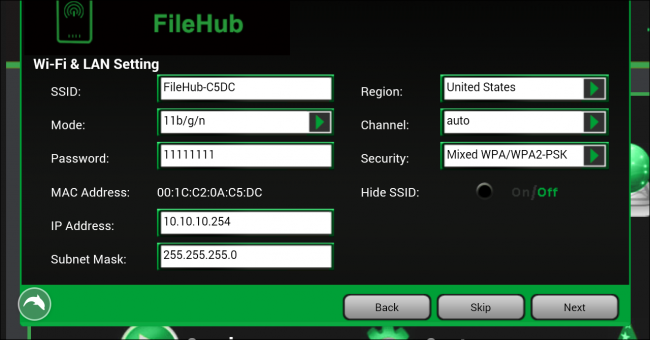
In the next step, regardless of whether or not you configured the device to connect to the internet via nearby Wi-Fi access point, you review the local settings including the device’s SSID, password, IP address, and other network configuration options. At minimum you should change the default password from “11111111” to something that isn’t included in the manual.
在下一步中,无论是否将设备配置为通过附近的Wi-Fi接入点连接到Internet,都将查看本地设置,包括设备的SSID,密码,IP地址和其他网络配置选项。 至少您应该将默认密码从“ 11111111”更改为手册中未包含的内容。
The next step is to set up a user password (this password will replace the blank no-password setup with a password of your choosing).
下一步是设置用户密码(此密码将用您选择的密码替换空白的无密码设置)。
After the device finishes rebooting and the changes are applied, repeat the login process to reconnect to the device. Remember your SSID password will be new and there will be a new password for the administrative control panel. You’ll see the normal dashboard, sans startup wizard.
设备完成重新启动并应用更改后,请重复登录过程以重新连接到设备。 请记住,您的SSID密码将是新密码,并且管理控制面板将有一个新密码。 您将看到普通的仪表板,没有启动向导。

Here you can adjust all the settings you set while using the startup wizard (and can, in fact, just run the wizard again if you want), as well as check to see that your SD card storage is mounted and do basic file manipulation via the Explore function. The file explorer on disk is pretty rudimentary, however, so we’d leave it as a tool of last resort.
在这里,您可以调整使用启动向导时设置的所有设置(实际上,如果需要,可以再次运行该向导),还可以检查是否已安装SD卡存储并通过以下操作进行基本文件操作浏览功能。 磁盘上的文件资源管理器还很初级,因此我们将其作为最后的手段。
It’s far more practical to connect to the device from another system (such as an Android phone) using a file browser capable of navigating network drives. For our purposes the Android file explorer app ES File Explorer is a perfect fit. You can easily fire up the app and navigate to the FileHub using the LAN file browser. Tap on the little world icon in ES File Explorer and then select LAN.
使用能够导航网络驱动器的文件浏览器从另一个系统(例如Android手机)连接到该设备要实用得多。 出于我们的目的,Android文件浏览器应用程序ES File Explorer非常适合。 您可以轻松启动应用程序,并使用LAN文件浏览器导航到FileHub。 在ES File Explorer中点击小世界图标,然后选择LAN。
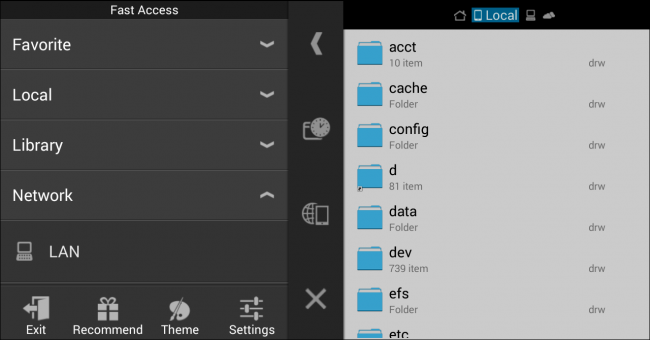
Select the entry for the FileHub (you’ll only see it if you’re connected to the FileHub) and entry the same login information you use to connect to the FileHub control panel.
选择FileHub的条目(仅在连接到FileHub时才看到),并输入用于连接FileHub控制面板的登录信息。
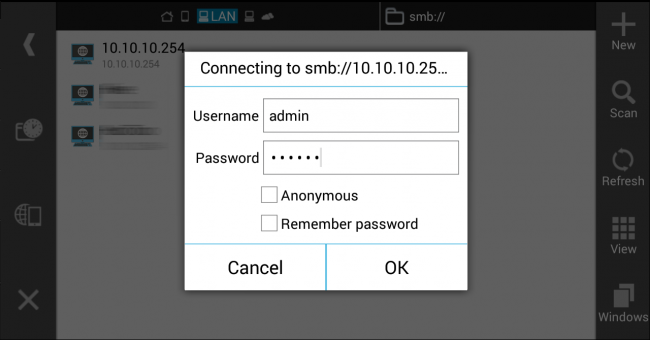
Once you’re logged into the network share, you can easily move and copy files between your device and the FileHub as well as stream media off of it.
登录到网络共享后,您可以轻松地在设备与FileHub之间移动和复制文件,以及从其中流式传输媒体。
它如何执行? (How Does It Perform?)
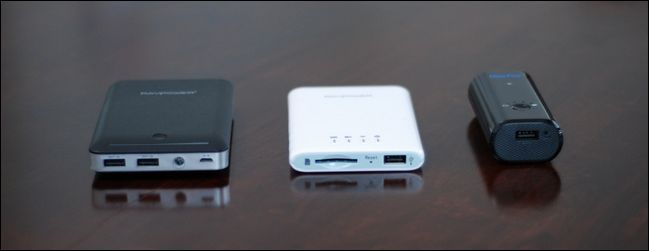
Setup was easy enough, but the real question is how well the FileHub performs. All the file transfer and hosting capabilities in the world aren’t worth much if the network connectivity stalls out all the time or the SD card fails to mount.
设置很容易,但是真正的问题是FileHub的性能如何。 如果网络连接一直停滞不前或SD卡无法安装,那么世界上所有文件传输和托管功能都不值钱。
In palling around with the device for the last few weeks we haven’t run into any stability issues, explainable connection drops, or other problems. In our tests the FileHub did a great job streaming music and video to companion devices (such as an iPad and an Android phone). It was also very easy to backup files from our portable devices to the FileHub’s SD card; when transferring large files the transfer speed was consistently around 1.6 MB/s. Given that we conducted our tests by transferring files from a phone’s internal microSD card via Wi-Fi to a second device (the FileHub) with a standard SD card, those speeds are quite satisfactory. They might not be blistering 802.11ac transfer rates but given the limitations of all the hardware in between the sending media and the receiving media, we are OK with the transfer speed and quality.
在过去的几周中,我们一直没有遇到任何稳定性问题,可解释的连接中断或其他问题。 在我们的测试中,FileHub出色地完成了将音乐和视频流传输到配套设备(例如iPad和Android手机)的工作。 从我们的便携式设备将文件备份到FileHub的SD卡也非常容易; 传输大文件时,传输速度始终约为1.6 MB / s。 假设我们进行了测试,是通过Wi-Fi将文件从手机内部的microSD卡传输到带有标准SD卡的第二个设备(FileHub),那么这些速度是令人满意的。 它们可能没有达到惊人的802.11ac传输速率,但是鉴于发送媒体和接收媒体之间所有硬件的局限性,我们对传输速度和质量表示满意。
When in use as a simple portable battery there were no hiccups, and the device was able to recharge our smartphones completely and our tablets partially (the 3,000 mAh battery can only do so much).
当作为简单的便携式电池使用时,不会出现打,的现象,该设备能够为我们的智能手机和平板电脑完全充电(3,000 mAh电池只能做很多事情)。
好的,坏的和判决 (The Good, The Bad, and The Verdict)
So after putting the device through the paces, what’s the verdict? Let’s break it down.
那么,在逐步掌握设备之后,会有什么判决? 让我们分解一下。
好: (The Good:)
- It’s very light and very slender; it’s about the size of a deck of cards, narrower, and weighs only 4.2 ounces. 它很轻很苗条。 它大约是一副纸牌的大小,较窄,重量仅为4.2盎司。
- Very easy setup; even with password updates and the like the setup process is around 30 seconds. 设置非常简单; 即使使用密码更新之类的程序,设置过程也大约需要30秒。
- SD card storage is easily upgradeable (and SD card prices are always falling). SD卡存储可轻松升级(并且SD卡价格始终在下降)。
- LED indicators are well designed and give immediate and useful feedback about the state of the device. LED指示器经过精心设计,可立即提供有关设备状态的有用反馈。
坏处: (The Bad:)
- We’d really love more juice in the little guy. 3,000 mAh isn’t a whole lot to go around. 我们真的希望小家伙多喝点果汁。 3,000 mAh容量不足。
- The file management software they suggest you download is pretty cruddy compared to solutions like ES File Explorer. 与ES File Explorer这样的解决方案相比,他们建议您下载的文件管理软件非常粗糙。
- No flashlight. We’ve said it before, and we’ll say it again: LEDs are so cheap there’s no good reason to not add a little LED flashlight to every portable battery pack. 没有手电筒。 我们之前已经说过,然后再说一遍:LED非常便宜,因此没有充分的理由不在每个便携式电池组中增加一个LED手电筒。
判决: (The Verdict:)
Despite the lack of LAN port (which we really loved on the TripMate) and the small-ish battery inside, the FileHub excels at exactly what it promises to do: linking your Wi-Fi devices together, giving you easy access to shared files, and offering a spot you can dump your files. The secondary functions, the backup battery and the ability to function as a Wi-Fi node when linked to an existing network, are really just bonus features on top of the solid file sharing and device linking functionality.
尽管缺少LAN端口(我们在TripMate上确实很喜欢它)和内部的小电池,但FileHub在其应做的事情上仍然表现出色:将Wi-Fi设备链接在一起,可以轻松访问共享文件,并提供一个可以转储文件的位置。 辅助功能,备用电池以及当链接到现有网络时可用作Wi-Fi节点的功能,实际上仅是可靠文件共享和设备链接功能之外的附加功能。
If you don’t need the hardwire LAN functionality offered by the TripMate and you’d really benefit from easily expandable but compact storage (like that offered by the FileHub’s SD card slot), there’s little reason to not pick up a FileHub.
如果您不需要TripMate提供的硬线LAN功能,并且真正受益于易于扩展但紧凑的存储(例如FileHub的SD卡插槽提供的存储),则没有理由不选择FileHub。





















 1922
1922

 被折叠的 条评论
为什么被折叠?
被折叠的 条评论
为什么被折叠?








